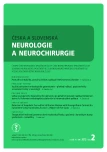Oligosymptomatic Forms of Myotonic Dystrophy Type 2
Authors:
Z. Ambler
Authors‘ workplace:
Neurologická klinika LF UK a FN Plzeň
Published in:
Cesk Slov Neurol N 2012; 75/108(2): 237-239
Category:
Case Report
Overview
Myotonic dystrophy type 2 (DM2) typically presents in adult life with lower extremity proximal muscle weakness, variously expressed myotonia and cataract being the most common symptoms. On electromyography (EMG) a broad spectrum of spontaneous activity with myotonic discharges can be found and motor unit action potentials may show myopathic pattern. Both clinical and EMG features in DM2 may be greatly variable. We present two cases of DM2 with proximal muscle weakness, spontaneous EMG activity but no myotonic discharges and no characteristic myopathic EMG pattern.
Key words:
myotonic dystrophy type 2 – myopathy – myotonia
Sources
1. Finsterer J. Myotonic dystrophy type 2. Eur J Neurol 2002; 9(5): 441–447.
2. Day JW, Ricker K, Jacobsen JF, Rasmussen LJ, Dick KA, Kress W et al. Myotonic dystrophy type 2: molecular, diagnostic and clinical spectrum. Neurology 2003; 60(4): 657–664.
3. Kukačka J, Kizek R, Průša R. Budoucnost zinkových metaloproteinů v laboratorní medicíně. Klin Biochem Metab 2008; 16(3): 161–170.
4. Suominen T, Bachinski LL, Auvinen S, Hackman P, Baggerly KA, Angelini C et al. Population frequency of myotonic dystrophy: higher than expected frequency of myotonic dystrophy type 2 (DM2) mutation in Finland. Eur J Hum Genet 2011; 19(7): 776–782.
5. Voháňka S, Bednařík J, Fajkusová L, Sedláčková J. Myotonická dystrofie typ 2: vzácné nebo časté onemocnění v České republice? Cesk Slov Neurol N 2005; 68/101(6): 390–393.
6. Meola G, Moxley RT jr. Myotonic dystrophy type 2 and related myotonic disorders. J Neurol 2004; 251(10): 1173–1182.
7. Chaudhry V, Johnson NM. Spectrum of clinical presentation in myotonic dystrophy type 2. Clin Neurophysiol 2008; 119: e54.
8. Logigian EL, Ciafaloni E, Quinn C, Dilek N, Pandya S, Moxley RT jr et al. Severity, type, and distribution of myotonic discharges are different in type 1 and type 2 myotonic dystrophy. Muscle Nerve 2007; 35(4): 479–485.
9. Milone M, Batish SD, Daube JR. Myotonic dystrophy type 2 with focal asymmetric muscle weakness and no electrical myotonia. Muscle Nerve 2009; 39(3): 383–385.
10. Auvinen S, Suominen T, Hannonen P, Bachinski LL, Krahe T, Udd B. Myotonic dystrophy type 2 found in two of sixty-three persons diagnosed as having fibromyalgia. Arthritis Rheum 2008; 58(11): 3627–3631.
11. Merlini L, Sabatelli P, Columbaro M, Bonifazi E, Pisani V, Massa R et al. Hyper-CK-emia as the sole manifestation of myotonic dystrophy type 2. Muscle Nerve 2005; 31(6): 764–767.
12. Schoser BG, Schneider-Gold C, Kress W, Goebel HH, Reilich P, Koch MC et al. Muscle pathology in 57 patients with myotonic dystrophy type 2. Muscle Nerve 2004; 29(2): 275–281.
13. Toth C, Dunham C, Suchowersky O, Parboosingh J, Brownell K. Unusual clinical, laboratory, and muscle histopathological findings in a family with myotonic dystrophy type 2. Muscle Nerve 2007; 35(2): 259–264.
Labels
Paediatric neurology Neurosurgery NeurologyArticle was published in
Czech and Slovak Neurology and Neurosurgery

2012 Issue 2
Most read in this issue
- The Use of Percutaneous Endoscopic Gastrostomy – Overview of Indications, Description of the Technique and Current Trends in Neurology
- Postural Instability, Gait Disorders and Falls in Parkinson’s Disease
- The Algorithm of CSF Examination according to the Reccomendation of the Committee of CSF and Neuroimmunology of the Czech Neurological Society
- Obstructive Sleep Apnoe and CPAP – is it Reasonable to Solve Nasal Patency?
